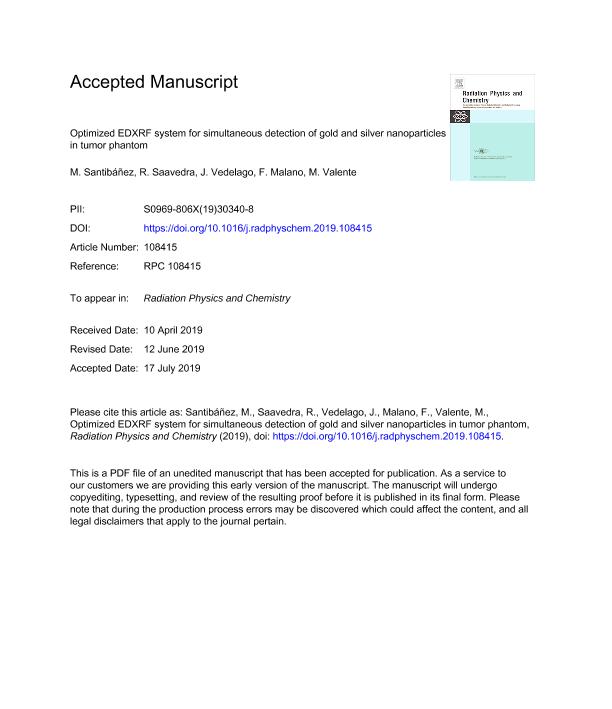Mostrar el registro sencillo del ítem
dc.contributor.author
Santibáñez, M.
dc.contributor.author
Saavedra, R.
dc.contributor.author
Vedelago, José Alberto

dc.contributor.author
Malano, Francisco Mauricio

dc.contributor.author
Valente, Mauro Andres

dc.date.available
2021-02-01T16:41:15Z
dc.date.issued
2019-12-24
dc.identifier.citation
Santibáñez, M.; Saavedra, R.; Vedelago, José Alberto; Malano, Francisco Mauricio; Valente, Mauro Andres; Optimized EDXRF system for simultaneous detection of gold and silver nanoparticles in tumor phantom; Pergamon-Elsevier Science Ltd; Radiation Physics and Chemistry (Oxford); 165; 24-12-2019; 1-20; 108415
dc.identifier.issn
0969-806X
dc.identifier.uri
http://hdl.handle.net/11336/124385
dc.description.abstract
An energy-dispersive X-ray fluorescence system (EDXRF) was optimized for simultaneous detection of gold and silver nanoparticles inside water-equivalent phantoms applied to theranostics. The optimization process was carried out in order to maximize the fluorescence detection, keeping dose levels as low as possible. Gold and silver fluorescent emissions were simultaneously detected emerging from phantom's volume, allowing the future development of multi-parametric imaging associated to specific tumor characteristics. For fluorescence detection, gold LIII-edge and silver K-edge emission lines were used, exited with a conventional X-ray source with a tungsten target. Several combinations of filters of different thickness were used to hardening the Bremsstrahlung spectrum, thus producing energetically narrow beams with central energy according to both excitation edges. In the case of gold, incident spectrum was optimized by means of strontium (Sr) and yttrium (Y) filters to relatively incrementing photons capable of exciting gold LIII-edge, while silver K-edge excitation was improved using a tin (Sn) filter. Filtering combinations made of 212.0 μm Sr with 94.5 μm Sn, and 130.2 μm Y with 94.5 μm Sn maximized fluorescence detection sensitivity and minimized delivered dose, resulting in doses 2.24 and 2.36 times lower than individual gold or silver fluorescent detection. Furthermore, when dual gold and silver fluorescent detection was performed, the minimum detectable concentration was lower than single element detection: 0.042 ± 0.002 mg/mL of Au and 0.024 ± 0.005 mg/mL of Ag in dual detection against 0.058 ± 0.003 mg/mL of Au and 0.124 ± 0.007 mg/mL of Ag when measured independently.
dc.format
application/pdf
dc.language.iso
eng
dc.publisher
Pergamon-Elsevier Science Ltd

dc.rights
info:eu-repo/semantics/openAccess
dc.rights.uri
https://creativecommons.org/licenses/by-nc-nd/2.5/ar/
dc.subject
GOLD NANOPARTICLES
dc.subject
IN VIVO EDXRF
dc.subject
SILVER NANOPARTICLES
dc.subject
TARGETING RADIOTHERAPY
dc.subject
TUMOR BIOMARKERS
dc.subject.classification
Física Atómica, Molecular y Química

dc.subject.classification
Ciencias Físicas

dc.subject.classification
CIENCIAS NATURALES Y EXACTAS

dc.title
Optimized EDXRF system for simultaneous detection of gold and silver nanoparticles in tumor phantom
dc.type
info:eu-repo/semantics/article
dc.type
info:ar-repo/semantics/artículo
dc.type
info:eu-repo/semantics/publishedVersion
dc.date.updated
2020-11-19T21:27:21Z
dc.journal.volume
165
dc.journal.pagination
1-20; 108415
dc.journal.pais
Estados Unidos

dc.journal.ciudad
Massachusetts
dc.description.fil
Fil: Santibáñez, M.. Universidad de La Frontera; Chile
dc.description.fil
Fil: Saavedra, R.. Universidad de La Frontera; Chile
dc.description.fil
Fil: Vedelago, José Alberto. Consejo Nacional de Investigaciones Científicas y Técnicas. Centro Científico Tecnológico Conicet - Córdoba. Instituto de Física Enrique Gaviola. Universidad Nacional de Córdoba. Instituto de Física Enrique Gaviola; Argentina. Universidad Nacional de Córdoba. Facultad de Matemática, Astronomía y Física; Argentina
dc.description.fil
Fil: Malano, Francisco Mauricio. Universidad de La Frontera; Chile
dc.description.fil
Fil: Valente, Mauro Andres. Consejo Nacional de Investigaciones Científicas y Técnicas. Centro Científico Tecnológico Conicet - Córdoba. Instituto de Física Enrique Gaviola. Universidad Nacional de Córdoba. Instituto de Física Enrique Gaviola; Argentina. Universidad Nacional de Córdoba. Facultad de Matemática, Astronomía y Física; Argentina. Universidad de La Frontera; Chile
dc.journal.title
Radiation Physics and Chemistry (Oxford)

dc.relation.alternativeid
info:eu-repo/semantics/altIdentifier/doi/http://dx.doi.org/10.1016/j.radphyschem.2019.108415
dc.relation.alternativeid
info:eu-repo/semantics/altIdentifier/url/https://www.sciencedirect.com/science/article/abs/pii/S0969806X19303408
Archivos asociados
